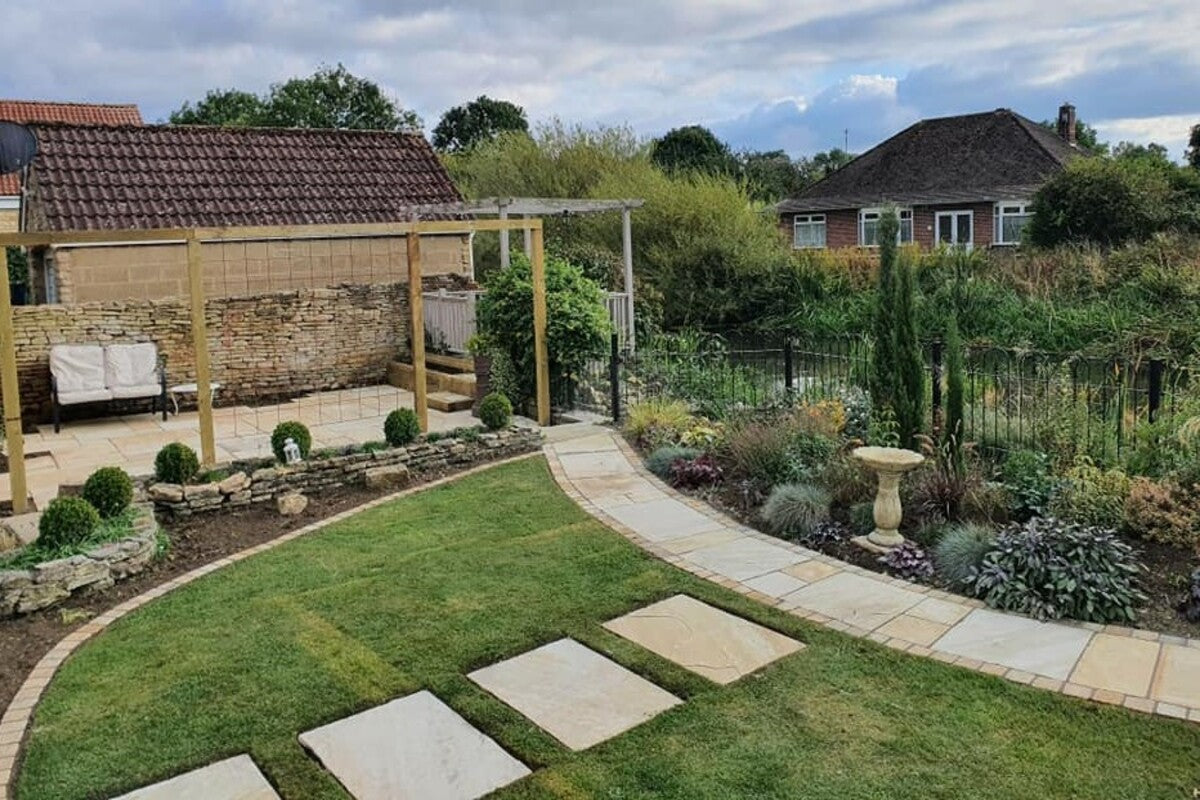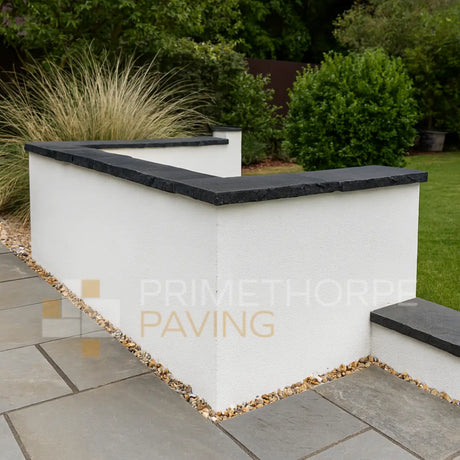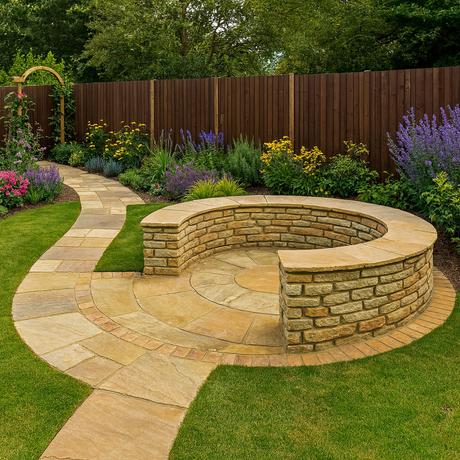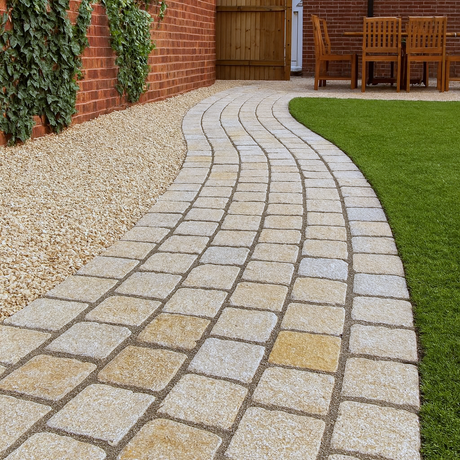Your garden should be your safe space and your place to relax and unwind. A lot of us would have realised over the pandemic years just how important outside space is. Being comfortable inside your home is one thing, but there's nothing like having a nice outdoor space to stretch your legs, soak up any sun and relax.
However, if you are not using your garden for what it's worth, or you find that your garden isn’t somewhere you want to relax – now might be a great time to invest in it. It doesn't have to be a complete overhaul, a nice new patio can give you an easy to maintain space to enjoy in a matter of days.

Strictly speaking, the foundations and groundwork required to install a patio to building spec is quite demanding, hence why professional landscaping can be very expensive. But if you were looking for a small update so you can enjoy your space sooner, you can lay paving slabs on grass with some tweaks and a specific method. We're going to spend the rest of the article going over exactly how to achieve this finish but still giving your patio the element of longevity it needs.
Please Note: Outdoor porcelain tiles are never suitable for laying without full and proper foundations, so should be avoided when using this method. Natural stone will work fine.
Key Takeaways:
- Preparation is Key: Before laying slabs, planning and designing the layout is crucial. Use scale drawings to visualize the placement and pattern of your paving accurately.
- Dry-Lay First: Arrange the paving stones on the grass to finalize the design. This step helps in adjusting the plan and understanding the exact sizes and quantities of slabs needed.
- Groundwork Matters: Remove grass and soil to a depth that accommodates the slab and at least 30mm extra for mortar. A minimum total depth of 60mm is recommended.
- Make a Makeshift Foundation: Instead of a full hardcore base, use a layer of compacted sharp sand for a quick DIY fix. Although not ideal, it provides temporary stability for the slabs.
- Mortar Mix is Crucial: A strong mortar mix is essential for the longevity of the patio. The right mix (4:1, 5:1, or 6:1 sand to cement) depends on your joint filling method and need for drainage.
What Tools Are Needed For Laying Paving Slabs On Grass
It's a simpler method than the heavy duty method used by professionals, but there is still a requirement for plenty of tools to get the job done. These tools include:
- Rubber mallet/hammer
- Disk grinder
- Wood block
- Chisel
- Shovel
- Spirit level
- Tape measure
- String Line
- Pegs
- Eye Protection
- Face covers
We would recommend extra protective clothing such as heavy-duty gloves and knee pads. You'll thanks us after!
Laying Slabs On Grass: The Planning Stage
The first thing you should do before beginning to lay slabs on grass is to plan it out. Take some time to grab a pen and paper, then draw out an aerial plan of your house, the shape of your garden and the features in it already. Then think about where you are going to place the paving slabs and steppingstones you want in your garden in order that you will most be able to enjoy it the most. Draw the size and shape of the pavers and patios to scale, so you end up with a drawing that gives you a very good idea of what you can achieve. It's important to use scale drawings as you will be able to properly analyse the pattern and placement of your paving and make changes if you're unsure.
Think about the lines of the garden path too. Will it be straight or curved and winding? We would recommend straight lines only when installing your own patio slabs onto grass as curves can be very difficult to get right.
If using stepping stones, how much space will you have between each slab? There is no right answer here, so be creative.

The Method: Dry-Lay & Removal of Grass & Soil When Laying Slabs On Grass
Once you have planned out your paved area and path, you need to place the paving stones where you think you would like them. This is where you may decide to deviate from the plan or change the design slightly.
First, It’s a good idea to lay the paving stones out on the grass in the pattern you have in mind. Then take a step back and see what you think - it's at this point you may realise that you don't actually like your plan, or you don't have the exact slab sizes you needed as packs of slabs don't always contain the exact same mix of sizes. It's much easier to make changes at this stage than after you've started using adhesive.
Rework your paper plan and redraw the slabs as you've just dry laid them. You will have to pick the slabs up and it's good to have the plan to refer to, so you are able to replicate it exactly as you liked it.
Once you've got your plan, it’s time to remove the grass and soil. Take your garden trowel and cut round the paving slabs around the edge of the dry-laid patio. Create a nice cut that's deep and wide enough so you can see exactly where the perimeter will be. Next, remove the grass and soil from the entire area - you will need to take up the paving slabs, so this is why redrawing your plan is so important.
Once you have done this, remove the soil and grass from beneath. Check the depth of your paving stones and ensure you have cut away enough for the paving slab to sit in the hole tightly, plus at least 30mm extra for the mortar bed. We would recommend removing a 60mm depth at a minimum in total.

Creating a Makeshift Foundation When Laying Paving Slabs On Grass
The foundation is a significant element that contributes to the longevity of the patio, but if you are looking to get a DIY fix in place quickly, then you want to ensure you are using an excellent mortar bed at the very least.
In lieu of a full hardcore bed/foundation layer, you can replace this with a good layer of compacted sharp sand. It's far from ideal, but as we mentioned, it's a DIY method that will keep you going for a summer or two. The first thing you need to do when applying a sub base is to add the sand to your newly dug hole. This will go some way help ensure that when your paving slabs are laid, they will not rock, crack or become damaged at a later date through general wear and tear and footfall.
It’s a good idea to use a rake at this point. It will help you to level out the sand and ensure it is evenly spread out. You should also use a wooden block to press down the sand - the more compact and level the layer of sand, the better the quality of the build. Make sure to hammer out any uneven surfaces and pack the sand as tightly as possible to give a firm foundation. You should spend as much time on this step as possible - the value added here is massive and well worth your time.
Once the sand has been raked, compacted and whacked as flat as possible, use a spirit level. This will confirm that the entire bottom of the hole is level and will be able to take a paving stone and keep it flat. If it is not level add more sand and rake accordingly until it is level.
The Correct Mortar Bed When Laying Paving Slabs On Grass
We've written a full an extensive guide on the mortar/cement mix you should be using to make sure your slabs stay put, which you can read here.
In summary, however, a strong mortar mix is going to be absolutely essential as with this DIY method, there is nowhere to hide. The mortar bed should be nice a strong. 4:1 is the standard strength, but 5 or 6:1 is also acceptable to allow drainage. Depending on what you are doing to the gaps between your slabs, it may mean one strength of mortar is preferable.
If you are going for a porous jointing compound which allows water to drain through, then a 6:1 is preferable to allow proper drainage. But if you are hand finishing the gaps with mortar, then 4:1 will be advisable as a strong mix will keep the patio steady.
Overview of How To Lay Paving Slabs On Grass
As you can see, when the project is broken down, step by step, it is simpler than you might first think. The key is to take your time to plan, measure and level. This will result in paving slabs on grass that last the test of time and look great for years to come. The makeshift foundation is essential to the DIY method working, so really make sure this is tight and compact.
If you need help choosing the right paving stones for your garden, call our specialist landscaping team for advice.







